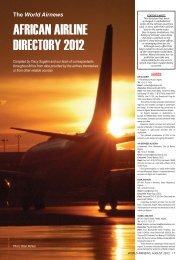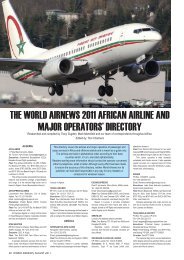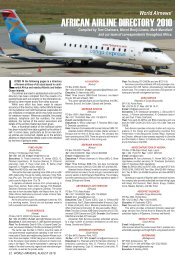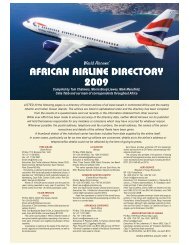May 2010 covers_Covers.qxd - World Airnews
May 2010 covers_Covers.qxd - World Airnews
May 2010 covers_Covers.qxd - World Airnews
You also want an ePaper? Increase the reach of your titles
YUMPU automatically turns print PDFs into web optimized ePapers that Google loves.
THE BRITISH public and indeed<br />
many, many others might think the<br />
Battle of Britain was won by the<br />
Spitfire, but I’m guessing most pilot readers<br />
are better educated.<br />
With 32 Hurricane squadrons on<br />
strength and only 19 Spitfire squadrons, it<br />
was the Hurricane’s fight.<br />
The “Hurri” went on to serve in all theatres,<br />
including North Africa, the Middle<br />
East, Burma and Russia. Only its thick wing<br />
restricted its further development as a<br />
fighter. However, its strength and loadcarrying<br />
ability enabled new roles such as<br />
fighter-bomber (‘Hurribomber’), tank<br />
buster (‘Flying Tin Openers’), operation<br />
from carriers as the Sea Hurricane and<br />
catapulting by rockets off merchant ships<br />
(‘Hurricats’).<br />
The Hurricane was the Royal Air Force‘s<br />
first monoplane fighter and the first capable<br />
of a level speed over 300 mph. It was<br />
designed by Sydney Camm, drawing on<br />
the tried-and-tested construction techniques<br />
used in the Hawker Hart and Hind<br />
bombers and Fury and Nimrod fighters,<br />
perhaps the most beautiful biplanes of all<br />
time. Hawker’s wood, fabric and tubular<br />
metal structures enabled Hurricanes to go<br />
into service earlier than the Spitfire, which<br />
used the then new and highly labour-intensive<br />
stressed-skin technology.<br />
The first impression of the Hurricane is<br />
that this is a big aeroplane. The Spitfire is<br />
almost dainty by comparison. There is a<br />
retractable step on the Hurricane just aft<br />
of the trailing edge that you will need to<br />
use to even get on the Hurricane wing and<br />
8 WORLD AIRNEWS, MAY <strong>2010</strong>.<br />
it takes yet another fuselage step to get<br />
over the cockpit rail and into the cockpit.<br />
It must have been quite a climb in the<br />
heat of a squadron scramble.<br />
Sitting inside the cockpit on the Irvin<br />
seat parachute is roomy and comfortable<br />
in a vintage kind of way, capacious at the<br />
hip and a tapering fit at the shoulders. I<br />
am six-foot tall and it is the most comfortable<br />
of all cockpits for me.<br />
The first impression of the cockpit layout<br />
is that below the standard RAF blind<br />
flying panel, controls, trims, indicators and<br />
the H-box of flap and undercarriage selector<br />
seem to be attached anywhere they<br />
can be mounted on the tubular frame. In<br />
terms of strength, it is like sitting inside<br />
the Forth Bridge.<br />
The view out of the cockpit ahead is<br />
very different to the Historic Aircraft Collection<br />
Mk.V Spitfire that I flew previously.<br />
Although it has the same 27 litres of supercharged<br />
V-12 Rolls Royce Merlin in<br />
front, the Hurricane nose drops away a little<br />
so there is better visibility forwards, although<br />
it is still poor by modern light<br />
aircraft standards.<br />
However, the view out to the side with<br />
the multi-framed canopy is like looking<br />
through a greenhouse, filled with irritating<br />
blind spots.<br />
I normally work around the cockpit<br />
from left to right. Battery, generator and<br />
avionics master switches all on; forward<br />
to the throttle and above the RPM lever.<br />
Unlike the Spitfire where they are in the<br />
same unit, the throttle and propeller units<br />
are separate. The mixture on G-HURI has<br />
two positions RUN and ICO, the engine<br />
works on one and not on the other – so it<br />
is easy to remember!<br />
Elevator trim – neutral; rudder trim –<br />
fully right. Fuel on and in the detent;<br />
check around the standard RAF blind flying<br />
panel, the undercarriage indicator<br />
lights – green light on. Unusually there are<br />
spare lights to check.<br />
ALL IN THE ‘H’<br />
The thing that most struck me when Charlie<br />
Brown did my conversion to type back in<br />
2005 was the ‘H’ undercarriage and flap<br />
selector. Undercarriage is on the left side of<br />
the ‘H’ and flaps on the right. At least<br />
there’s a safety catch to prevent you raising<br />
the gear while on the ground. It looks like a<br />
car gear selector, but I doubt whether<br />
learner drivers fret about it as much as I did<br />
when I started flying the Hurri.<br />
I move the selector to flaps down and<br />
test what is a quite excellent hydraulic hand<br />
pump. For the first of many times in the<br />
prep and flight I will check that I have selected<br />
the flap gate and not the undercarriage.<br />
The hand pump can also be used to<br />
pump the undercarriage down if there is a<br />
loss of power in flight. There is also a foot<br />
pedal that if pushed forward will allow the<br />
undercarriage to lower in flight by gravity.<br />
Now I am ready for engine start. I unscrew<br />
the Ki-gas primer, make six pumps<br />
after the pressure comes up and lock it.<br />
Stick back into my stomach, brakes on and<br />
with sufficient pressure and parking catch<br />
on. The Hurricane, like the Spit, needs<br />
three hands to start. The start and boost






